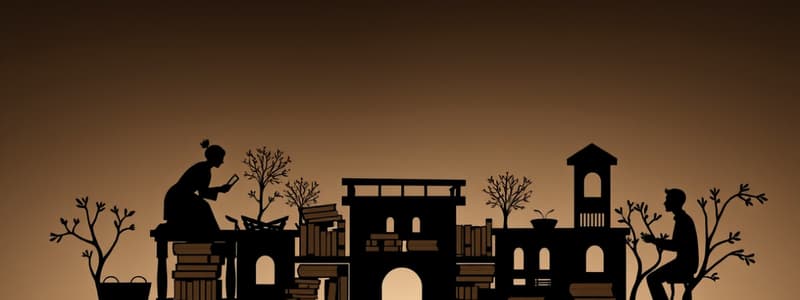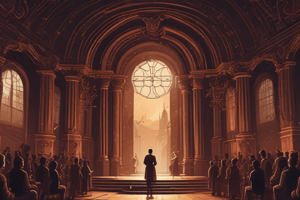Podcast
Questions and Answers
What is the primary function of the prologue in a play?
What is the primary function of the prologue in a play?
- To build up to the climax of the story
- To conclude the main action of the play
- To introduce characters and setting before the action begins (correct)
- To resolve the conflicts presented in the plot
Which component of dramatic structure signifies the most intense point of the play?
Which component of dramatic structure signifies the most intense point of the play?
- Epilogue
- Prologue
- Climax (correct)
- Scene
What do acts in a play primarily represent?
What do acts in a play primarily represent?
- Small divisions of the plot with changing characters
- Larger divisions that contain the main action and character conflicts (correct)
- Conclusions that resolve the story's themes
- The setting in which the characters exist
How are scenes in a play characterized?
How are scenes in a play characterized?
What literary element describes the time, place, and social situation of a story?
What literary element describes the time, place, and social situation of a story?
What is the primary function of a flashback in a narrative?
What is the primary function of a flashback in a narrative?
Which type of irony involves a discrepancy between what the audience knows and what the characters know?
Which type of irony involves a discrepancy between what the audience knows and what the characters know?
What distinguishes third-person limited point of view from third-person omniscient?
What distinguishes third-person limited point of view from third-person omniscient?
What is an example of indirect foreshadowing?
What is an example of indirect foreshadowing?
What is Chekhov's Gun principle in relation to foreshadowing?
What is Chekhov's Gun principle in relation to foreshadowing?
What is the primary setting of the story Matilda?
What is the primary setting of the story Matilda?
Which literary device does the author use to allow readers to visualize scenes in Matilda?
Which literary device does the author use to allow readers to visualize scenes in Matilda?
What motivates Matilda to take revenge against her father?
What motivates Matilda to take revenge against her father?
Which character in Matilda is portrayed as a loving figure?
Which character in Matilda is portrayed as a loving figure?
What theme does Matilda's relationship with Miss Honey primarily illustrate?
What theme does Matilda's relationship with Miss Honey primarily illustrate?
What does Miss Trunchbull represent in the story?
What does Miss Trunchbull represent in the story?
How does Matilda communicate her message to Miss Trunchbull?
How does Matilda communicate her message to Miss Trunchbull?
What does structural irony involve?
What does structural irony involve?
In which example does verbal irony manifest?
In which example does verbal irony manifest?
What type of irony is present in Mrs. Mallard's situation in 'The Story of an Hour'?
What type of irony is present in Mrs. Mallard's situation in 'The Story of an Hour'?
What is a key characteristic of idioms?
What is a key characteristic of idioms?
How is symbolism effectively identified in literature?
How is symbolism effectively identified in literature?
What is the role of imagery in literature?
What is the role of imagery in literature?
What does alliteration enhance in a piece of literature?
What does alliteration enhance in a piece of literature?
What distinguishes figurative language from literal language?
What distinguishes figurative language from literal language?
Flashcards are hidden until you start studying
Study Notes
Drama and Structure
- A drama is a story performed on stage for an audience.
- Dramatic structure consists of acts, scenes, prologues, and epilogues.
- The prologue introduces characters and settings before the main story begins.
- Acts are major divisions within a play, revealing character conflicts and complications.
- Complications lead to a climax, the pivotal moment that determines the outcome.
- Plays conclude with a resolution that resolves plot points.
- Scenes are subdivisions of acts that change with new settings or characters.
- The epilogue summarizes the play's events and may provoke audience reactions.
Literary Elements
- Literary elements include conflict, characters, plot, setting, and theme.
- Conflict is the struggle between opposing forces, categorized as internal or external.
- Characters are essential to conflict; they can be people, animals, or figures.
- The plot is a series of events driven by conflict, typically structured in five stages.
- Setting involves the time, place, and social context affecting the story.
- Theme conveys the central message or lesson of the narrative, often revealed through conflicts.
Point of View
- Point of view determines the reader's perspective on the story.
- First-person point of view uses "I" and "we" to create intimacy with the narrator.
- Second-person point of view addresses the reader using "you," creating direct involvement.
- Third-person point of view employs "he," "she," or "it," allowing for broader information delivery.
- Third-person types: omniscient (all-knowing), limited (single character focus), and objective (no interior thoughts).
Flashbacks
- Flashbacks introduce past events into the narrative to provide context and character insight.
- Variants include dream flashbacks, straight break flashbacks, and memory flashbacks.
- Flashbacks enhance storytelling by revealing critical background information.
Foreshadowing
- Foreshadowing hints at future events to create suspense and narrative tension.
- Two types: direct (explicit hints) and indirect (subtle or implied clues).
- Chekhov's Gun principle states every detail should serve a purpose in the story.
Irony
- Irony highlights contrasts between reality and expectations, often for humor or critique.
- Types of irony include verbal (literal meaning vs. intended meaning), situational (surprising outcomes), and dramatic (audience knows more than characters).
- Real-life examples demonstrate irony's relevance in everyday situations.
Language in Literature
- Literal language conveys exact meanings, whereas figurative language employs metaphors, similes, and hyperbole for deeper significance.
- Figurative language enriches narratives, while literal language aids clarity in genres like instruction or analysis.
Idioms
- Idioms are figurative expressions common in everyday language, enriching communication.
- Examples include "pass the buck" and "keep your chin up," offering deeper cultural meanings.
Symbolism and Imagery
- Symbolism conveys layered meanings, revealed through context and repetition.
- Imagery appeals to the senses and includes various types like visual and auditory, enhancing reader connection to the narrative.
Alliteration and Writing Style
- Alliteration involves repetition of initial consonant sounds, adding rhythm and tone.
- Writing style encompasses diction, figurative language, and literary techniques, reflecting the author's identity and story depth.
Case Study: Matilda by Roald Dahl
- "Matilda" is narrated in third-person, focusing on Matilda's complex family dynamics.
- Matilda grapples with uncaring parents and the tyrannical headmistress Miss Trunchbull.
- Themes include the importance of education and the idea of family beyond blood relations.
- The setting features a small English village and various locales critical to the plot's development.
- Key conflicts revolve around adult cruelty towards children, culminating in Matilda's triumph with the help of her teacher, Miss Honey.
Themes in "Matilda"
- Education and familial bonds are central themes where knowledge is valued and emotional connections transcend blood ties.
- Matilda represents intelligence and resilience against oppressive figures in her life.### Matilda and Key Characters
- Miss Honey is kind and loving but lives in poverty due to her aunt, Miss Trunchbull, who stole her inheritance.
- Lavender is Matilda's intelligent and mischievous best friend.
- Michael Wormwood, Matilda's older brother, embodies normalcy but gradually adopts his father's scamming tendencies.
- These characters are essential for conveying the novel's overarching themes and messages.
Figurative Language in Matilda
- Figurative language enhances understanding and visualization of concepts.
- Similes compare dissimilar things using “like” or “as”.
- Personification attributes human qualities to inanimate objects or animals.
- Matilda effectively employs similes and personification throughout the story.
Insights into Matilda's Family
- Harry Wormwood views his customers as easy targets to deceive.
- Zinnia Wormwood prioritizes physical appearance over intellect, disregarding the value of books.
- Both parents overlook Matilda's intelligence and unique perspectives, favoring shallow beliefs.
- Matilda's parents abandon her with Miss Honey while they escape to Spain, highlighting their neglect.
Overview of James and the Giant Peach
- James and the Giant Peach, a fantasy by Roald Dahl, was published in 1961.
- Central characters include James Trotter and anthropomorphic garden bugs: Centipede, Miss Spider, Old Green Grasshopper, Earthworm, Ladybug, and Silkworm.
- The story begins in England, progresses aboard a giant peach, and ends in New York City.
- James learns valuable lessons about friendship, courage, and acceptance through shared adventures.
Settings in James and the Giant Peach
- The story opens in James's unhappy home, where he faces abuse from Aunt Sponge and Aunt Spiker.
- The narrative shifts to the Atlantic Ocean after the giant peach rolls down the hill, adding danger and suspense.
- The plot progresses to New York City, where James finds acceptance and a new life, living in a peach pit in Central Park.
Themes of Friendship and Family
- James evolves from loneliness to finding a new family among his insect friends.
- The journey of acceptance helps James understand the importance of companionship and love.
Conflicts in James and the Giant Peach
- The primary conflict revolves around James's oppressive living situation with his cruel aunts.
- James's decision to escape through magic showcases his desire for a better life.
- Various smaller conflicts arise as James and his friends work together to face challenges.
Symbolism in James and the Giant Peach
- Magical green objects symbolize hope and the possibility of a better life.
- The giant peach represents a nurturing environment for James, contrasting his previous hardships.
- The act of dropping the green objects signifies significant loss and change.
- The talking insects embody themes of friendship and support.
Foreshadowing and Suspense
- James's anticipation builds when he receives magical crystals, hinting at life-changing events.
- The floating peach foreshadows adventures and transformations in James’s life.
- James's journey in the giant peach signifies a shift from loneliness to belonging, emphasizing newfound friendships.
Studying That Suits You
Use AI to generate personalized quizzes and flashcards to suit your learning preferences.




